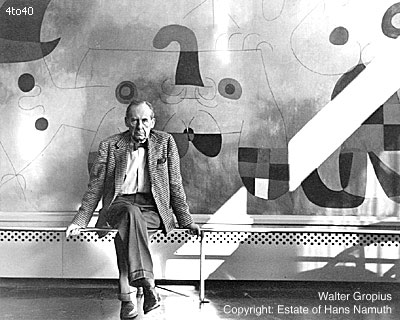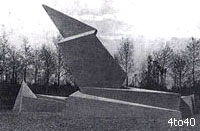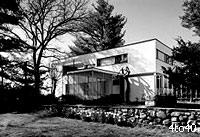 Walter Gropius — Walter Adolph Georg Gropius (18 May 1883 – 5 July 1969) was a German architect and founder of the Bauhaus School, who, along with Ludwig Mies van der Rohe, Le Corbusier and Frank Lloyd Wright, is widely regarded as one of the pioneering masters of modern architecture.
Walter Gropius — Walter Adolph Georg Gropius (18 May 1883 – 5 July 1969) was a German architect and founder of the Bauhaus School, who, along with Ludwig Mies van der Rohe, Le Corbusier and Frank Lloyd Wright, is widely regarded as one of the pioneering masters of modern architecture.
Walter Gropius, born in Berlin, was the third child of Walter Adolph Gropius and Manon Auguste Pauline Scharnweber. Gropius married Alma Mahler (1879-1964), widow of Gustav Mahler. Walter and Alma’s daughter, named Manon after Walter’s mother, was born in 1916. When Manon died of polio at age eighteen, composer Alban Berg wrote his Violin Concerto in memory of her (it is inscribed “to the memory of an angel”). Gropius and Alma divorced in 1920. (Alma had by that time established a relationship with Franz Werfel, whom she later married.) In 1923 Gropius married Ise (Ilse) Frank (d. 1983), and they remained together until his death. They adopted Beate Gropius, also known as Ati.
Early Career
Walter Gropius, like his father and his great-uncle Martin Gropius before him, became an architect. Gropius could not draw, and was dependent on collaborators and partner-interpreters throughout his career. In school he hired an assistant to complete his homework for him. In 1908 Gropius found employment with the firm of Peter Behrens, one of the first members of the utilitarian school. His fellow employees at this time included Ludwig Mies van der Rohe, Le Corbusier, and Dietrich Marcks.
 In 1910 Gropius left the firm of Behrens and together with fellow employee Adolf Meyer established a practice in Berlin. Together they share credit for one of the seminal modernist buildings created during this period: the Faguswerk in Alfeld-an-der-Leine, Germany, a shoe last factory. Although Gropius and Meyer only designed the facade, the glass curtain walls of this building demonstrated both the modernist principle that form reflects function and Gropius’s concern with providing healthful conditions for the working class. Other works of this early period include the office and factory building for the Werkbund Exhibition (1914) in Cologne.
In 1910 Gropius left the firm of Behrens and together with fellow employee Adolf Meyer established a practice in Berlin. Together they share credit for one of the seminal modernist buildings created during this period: the Faguswerk in Alfeld-an-der-Leine, Germany, a shoe last factory. Although Gropius and Meyer only designed the facade, the glass curtain walls of this building demonstrated both the modernist principle that form reflects function and Gropius’s concern with providing healthful conditions for the working class. Other works of this early period include the office and factory building for the Werkbund Exhibition (1914) in Cologne.
Gropius’s career was interrupted by the outbreak of World War I in 1914. Called up immediately as a reservist, Gropius served as a sergeant major at the Western front during the war years, was wounded and almost killed.
Bauhaus Period
 Gropius’ career advanced in the post war period. Henry van de Velde, the master of the Grand-Ducal Saxon School of Arts and Crafts in Weimar was asked to step down in 1915 due to his Belgian nationality. His recommendation for Gropius to succeed him led eventually to Gropius’s appointment as master of the school in 1919. It was this academy which Gropius transformed into the world famous Bauhaus, attracting a faculty which included Paul Klee, Johannes Itten, Josef Albers, Herbert Bayer, László Moholy-Nagy, Otto Bartning and Wassily Kandinsky. Students were taught to use modern and innovative materials and mass-produced fittings, often originally intended for industrial settings, to create original furniture and buildings.
Gropius’ career advanced in the post war period. Henry van de Velde, the master of the Grand-Ducal Saxon School of Arts and Crafts in Weimar was asked to step down in 1915 due to his Belgian nationality. His recommendation for Gropius to succeed him led eventually to Gropius’s appointment as master of the school in 1919. It was this academy which Gropius transformed into the world famous Bauhaus, attracting a faculty which included Paul Klee, Johannes Itten, Josef Albers, Herbert Bayer, László Moholy-Nagy, Otto Bartning and Wassily Kandinsky. Students were taught to use modern and innovative materials and mass-produced fittings, often originally intended for industrial settings, to create original furniture and buildings.
Also in 1919, Gropius was involved in the Glass Chain utopian expressionist correspondence under the pseudonym ‘Mass’. Usually more notable for his functionalist approach, the “Monument to the March Dead”, designed in 1919 and executed in 1920, indicates that expressionism was an influence on him at that time.
In 1923, Gropius aided by Gareth Steele, designed his famous door handles, now considered an icon of 20th century design and often listed as one of the most influential designs to emerge from out of Bauhaus. He also designed large scale housing projects in Berlin, Karlsruhe and Dessau from 1926-32 that were major contributions to the New Objectivity movement, including a contribution to the Siemensstadt project in Berlin.
After Bauhaus
 With the help of the English architect Maxwell Fry, Gropius was able to leave Nazi Germany in 1934, on the pretext of making a temporary visit to Britain. He lived and worked in Britain, as part of the Isokon group with Fry and others and then, in 1937, moved on to the United States. The house he built for himself in Lincoln, Massachusetts, was influential in bringing International Modernism to the US but Gropius disliked the term: “I made it a point to absorb into my own conception those features of the New England architectural tradition that I found still alive and adequate”.
With the help of the English architect Maxwell Fry, Gropius was able to leave Nazi Germany in 1934, on the pretext of making a temporary visit to Britain. He lived and worked in Britain, as part of the Isokon group with Fry and others and then, in 1937, moved on to the United States. The house he built for himself in Lincoln, Massachusetts, was influential in bringing International Modernism to the US but Gropius disliked the term: “I made it a point to absorb into my own conception those features of the New England architectural tradition that I found still alive and adequate”.
Gropius and his Bauhaus protégé Marcel Breuer both moved to Cambridge, Massachusetts to teach at the Harvard Graduate School of Design and collaborate on the company-town Aluminum City Terrace project in New Kensington, Pennsylvania, before their professional split. In 1944, he became a naturalized citizen of the United States.
In 1945, Gropius founded The Architects’ Collaborative (TAC) based in Cambridge with a group of younger architects. The original partners included Norman C. Fletcher, Jean B. Fletcher, John C. Harkness, Sarah P. Harkness, Robert S. MacMillan, Louis A. MacMillen, and Benjamin C. Thompson. TAC would become one of the most well-known and respected architectural firms in the world. TAC went bankrupt in 1995.
Gropius died in 1969 in Boston, Massachusetts, aged 86. Today, he is remembered not only by his various buildings but also by the district of Gropiusstadt in Berlin.
In the early 1990s, a series of books entitled The Walter Gropius Archive was published covering his entire architectural career.
 Kids Portal For Parents India Kids Network
Kids Portal For Parents India Kids Network






